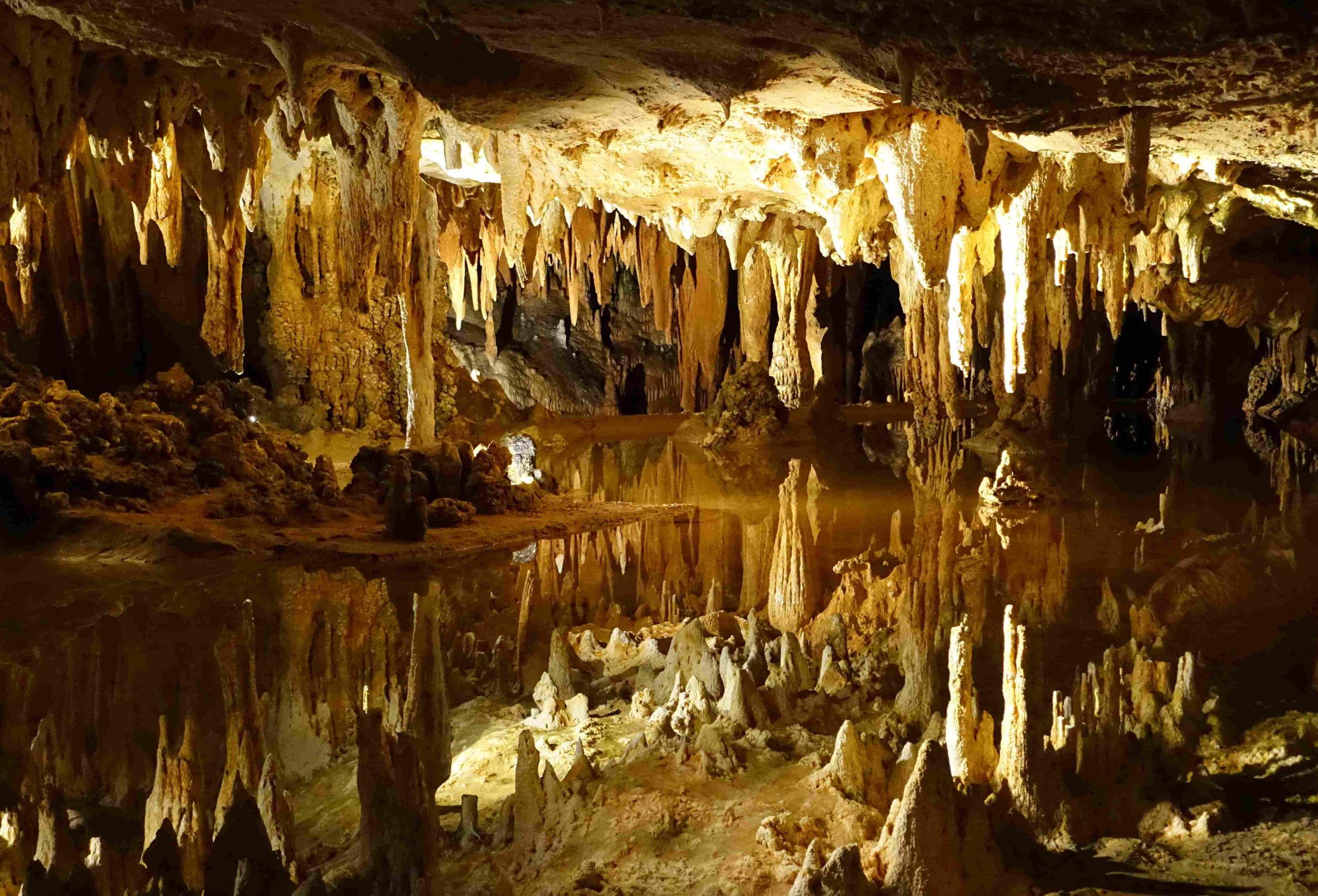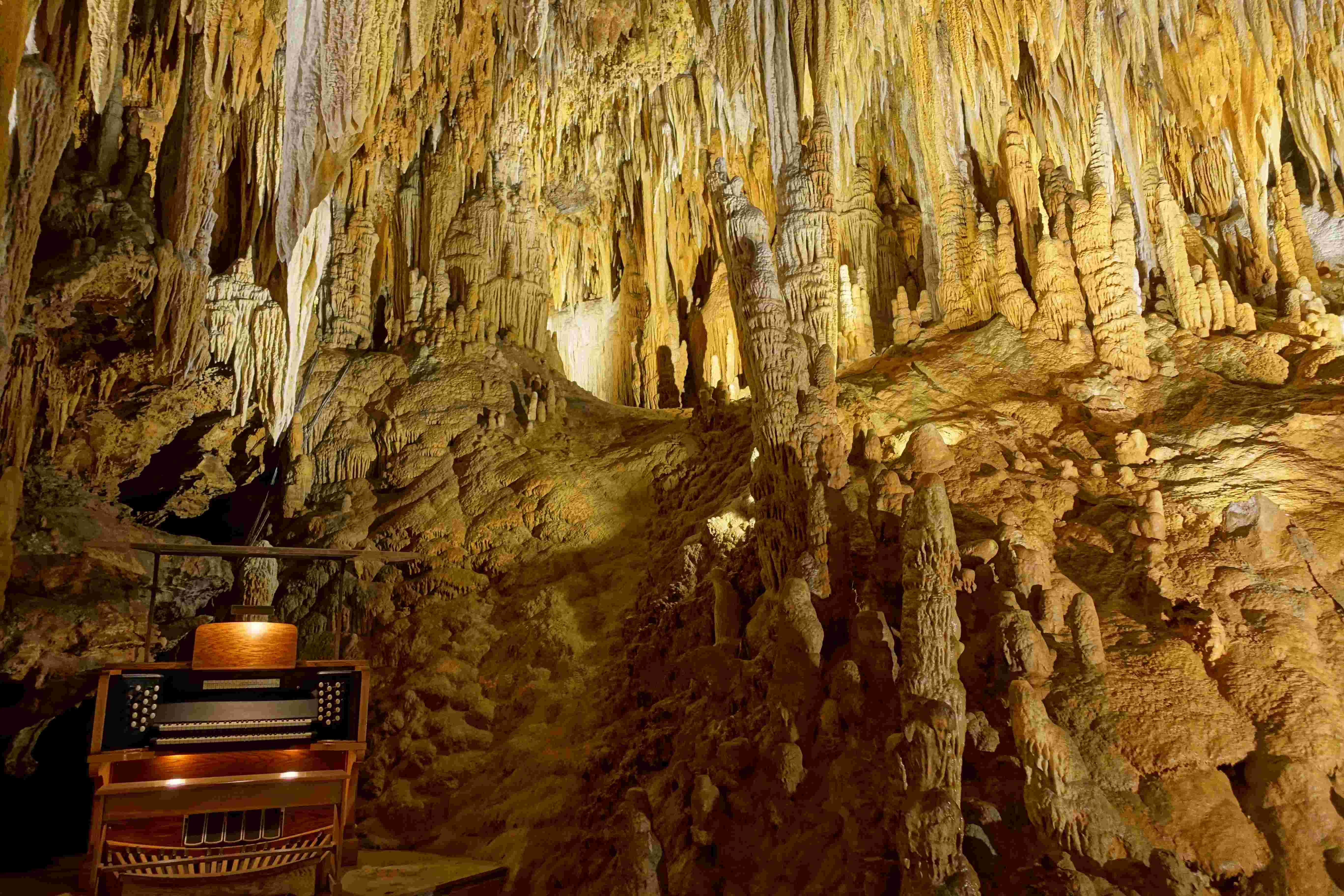Flowstone in Luray Caverns is a mesmerizing natural phenomenon that has captivated visitors for generations. These stunning formations, created by the slow deposition of minerals over thousands of years, showcase nature’s artistry in its purest form. From delicate draperies to massive cascades, the flowstone in Luray Caverns presents a diverse array of shapes, colors, and textures that contribute to the cave’s otherworldly beauty.
What is Flowstone and How Does it Form in Luray Caverns?

Flowstone is a type of speleothem, or cave formation, that results from the slow accumulation of minerals deposited by flowing water. In Luray Caverns, this process begins with rainwater seeping through the soil above the cave. As it percolates through decaying vegetation, the water becomes slightly acidic, allowing it to dissolve the limestone bedrock.
When this mineral-rich water enters the cave, it flows over surfaces, depositing thin layers of calcite as it evaporates. Over time, these layers build up to create smooth, flowing formations that resemble frozen waterfalls or draped fabric.
The formation process of flowstone in Luray Caverns involves several key steps:
- Water absorption of carbon dioxide from the soil
- Dissolution of limestone as water travels through rock
- Entrance of mineral-laden water into the cave
- Evaporation and deposition of calcite on cave surfaces
- Gradual buildup of layers over thousands of years
What Are the Most Famous Flowstone Formations in Luray Caverns?

Luray Caverns boasts several renowned flowstone formations that have become iconic symbols of the cave’s beauty. Here are some of the most notable:
Saracen’s Tent
This extraordinary formation is perhaps the most famous example of flowstone in Luray Caverns. Saracen’s Tent features a series of thin, translucent draperies arranged in a circular pattern, resembling the fabric walls of a tent. What makes this formation truly unique is its musical quality – when struck gently, the draperies produce bell-like tones, adding an auditory dimension to their visual splendor.
Titania’s Veil
Named after the Fairy Queen from Shakespeare’s “A Midsummer Night’s Dream,” Titania’s Veil is a pristine white flowstone formation that exemplifies the purity of calcite deposits in the caverns. Its delicate, lace-like appearance has made it a favorite subject for postcards and cave memorabilia.
Hovey’s Balcony Draperies
In an area known as Hovey’s Balcony, visitors can marvel at a stunning display of sixteen flowstone draperies hanging side by side. Three of these draperies are pure white and as fine as crape shawls, while the remaining thirteen exhibit beautiful striations in various shades of brown, reminiscent of agate stone.
How Do Colors Vary in Luray Caverns’ Flowstone?
The flowstone in Luray Caverns presents a remarkable palette of colors, each hue telling a story of the minerals present during formation. Here’s a breakdown of the colors you might encounter and their origins:
| Color | Cause | Example Formation |
|---|---|---|
| White | Pure calcite | Titania’s Veil |
| Red | Iron oxide | Empress Column (rose-colored) |
| Yellow | Iron compounds | Various draperies |
| Black | Manganese dioxide | Certain flowstone sheets |
| Blue | Copper compounds | Rare formations |
| Green | Copper compounds | Occasional small deposits |
The interplay of these colors creates a visually stunning environment, with each formation offering a unique spectacle. The Empress Column, for instance, stands out with its rose-colored hue, while the Double Column features contrasting pillars of snowy white alabaster.
What Types of Flowstone Can Be Found in Luray Caverns?
Flowstone in Luray Caverns manifests in various forms, each with its own characteristics and formation process. The main types include:
-
Draperies or Curtains: These thin, often translucent formations resemble hanging fabric. Examples include Saracen’s Tent and the draperies in Hovey’s Balcony.
-
Cascades: Formations like Brand’s Cascade mimic frozen waterfalls, appearing as if liquid has been caught mid-flow and transformed into stone.
-
Sheets: Large, solid flowstone formations that cover extensive areas of walls or ceilings. These can be found throughout the caverns and often serve as backdrops for other formations.
-
Stalactites and Stalagmites: While not strictly flowstone, these formations often incorporate flowstone elements as water flows over their surfaces.
How Does Flowstone Contribute to Luray Caverns’ Ecosystem?
Flowstone plays a crucial role in the delicate ecosystem of Luray Caverns:
- Habitat Creation: The varied textures and surfaces of flowstone provide niches for cave-dwelling organisms.
- Water Filtration: As water flows over flowstone, it undergoes natural filtration, affecting the cave’s overall water quality.
- Climate Regulation: Flowstone formations help maintain the cave’s humidity and temperature by facilitating water movement and evaporation.
- Geological Record: The layers in flowstone formations serve as a record of past climate conditions, offering valuable data for scientific research.
What Conservation Efforts Protect Flowstone in Luray Caverns?
Preserving the delicate flowstone formations in Luray Caverns is a top priority. Several conservation measures are in place:
- Controlled Access: Visitor paths are carefully designed to minimize impact on formations.
- Climate Control: Monitoring and maintaining optimal temperature and humidity levels to prevent drying or excessive moisture.
- Education: Informing visitors about the fragility of formations and the importance of not touching them.
- Scientific Research: Ongoing studies to better understand formation processes and conservation needs.
- Lighting: Use of LED lights that don’t generate excess heat or encourage algae growth.
How Can Visitors Best Experience Flowstone in Luray Caverns?
To fully appreciate the flowstone in Luray Caverns, consider these tips:
- Join guided tours for expert insights into formation processes and history.
- Bring a camera to capture the intricate details of formations (without flash).
- Take your time at each formation to observe subtle color variations and textures.
- Listen for the musical qualities of formations like Saracen’s Tent.
- Visit during different seasons to observe how changing surface conditions affect cave humidity and formation appearance.
By understanding and respecting the flowstone formations in Luray Caverns, visitors can contribute to the preservation of these natural wonders for future generations to enjoy and study.

